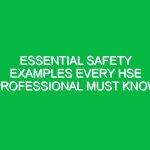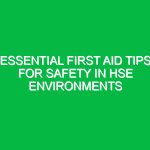Introduction: Understanding the Purpose of Our Toolbox Talk
Hello team! Today, we’re gathering for our Toolbox Talk to discuss a crucial concept that can significantly enhance our approach to Health, Safety, and Environment (HSE) at work: What is Your “Why”. This idea is not just a motivational phrase; it’s a fundamental aspect of our Safety culture. By understanding and articulating our “why,” we can foster a safer, more engaged environment where every individual feels responsible for their Safety and that of their colleagues.
The Importance of Your “Why” in HSE
So, what exactly do we mean by What is Your “Why”? At its core, your “why” is the reason behind your commitment to safety. It encompasses your personal motivations, your values, and the outcomes you wish to achieve by adhering to safety protocols. Understanding your “why” is essential for several reasons:
- Increases Engagement: When you identify your personal motivation for safety, you are more likely to engage in safety practices actively.
- Improves Decision Making: Knowing your “why” helps you make better decisions, especially in high-stress situations where safety protocols must be followed.
- Enhances Team Cohesion: Sharing your “why” with your colleagues fosters a stronger team connection and encourages open communication about safety.
- Reduces Risks: A clear understanding of personal motivations can lead to a more cautious approach, ultimately reducing the likelihood of accidents.
Exploring the Components of Your “Why”
Let’s dive deeper into the components of What is Your “Why”. Understanding these aspects can help you articulate your motivations and integrate them into your daily work routine:
1. Personal Values
Your values are the guiding principles that influence your behavior. What do you value most in your work? Is it teamwork, responsibility, or perhaps the well-being of your family? Identifying these values allows you to connect them to safety practices. For instance, if family is a core value, you might commit to following safety protocols to ensure you return home safe every day.
2. Desired Outcomes
What do you wish to achieve through your commitment to safety? This could range from maintaining a safe work environment to achieving zero accidents. By setting clear goals, you can focus your efforts on actions that contribute to these outcomes.
3. Past Experiences
Your past experiences, especially those related to safety, shape your perspective. Have you or someone you know experienced an accident due to negligence? Such experiences can strengthen your resolve to prioritize safety in the workplace.
4. Community Impact
Consider the impact of your actions on your colleagues, family, and community. When you realize that your commitment to safety affects not just you but everyone around you, it reinforces the importance of maintaining a safe working environment.
Real-Life Scenarios: Applying Your “Why”
Let’s consider a couple of hypothetical scenarios to illustrate how understanding your “why” can influence behavior in the workplace:
Scenario 1: The Forklift Operator
Imagine a forklift operator who knows their “why.” They’ve experienced a close call in the past and are motivated by their family’s well-being. This operator takes extra time to check their surroundings before moving, ensuring that the path is clear. Their commitment to safety is not just a rule to follow; it’s a personal mission rooted in their values. As a result, they reduce the risk of accidents, benefiting themselves and their coworkers.
Scenario 2: The Construction Crew
Now, think about a construction crew that regularly discusses their “whys.” They’ve created a culture where each member shares their motivations for safety. One member might emphasize the importance of returning home to their children, while another may focus on building a reputation for excellence in safety. This open dialogue fosters accountability and encourages everyone to look out for one another, ultimately leading to a safer worksite.
Best Practices for Discovering and Sharing Your “Why”
Now that we’ve explored the importance of What is Your “Why” and seen its practical applications, let’s discuss some Best Practices for discovering and sharing your motivations:
1. Reflect on Your Motivations
Take a moment to think about what drives you. Consider the following questions:
- What personal experiences have shaped my views on safety?
- Who do I want to keep safe, and why?
- What outcomes do I hope to achieve by prioritizing safety?
2. Share with Your Team
Engage your colleagues in conversations about their “whys.” You can do this during Toolbox Talks or team meetings. Sharing personal motivations creates a supportive environment and enhances team cohesion.
3. Integrate Your “Why” into Daily Practices
Once you’ve identified your “why,” integrate it into your daily work routine. Remind yourself of your motivations before starting a task. For example, if your “why” is to ensure your family’s safety, visualize them when you put on your Safety Gear.
4. Encourage Others to Find Their “Why”
As a team member, encourage your coworkers to find and share their “whys.” Create an atmosphere where everyone feels comfortable discussing personal motivations. This can lead to a more engaged workforce focused on safety.
Potential Hazards and Safety Considerations
Understanding your “why” also helps in recognizing potential Hazards in the workplace. When you are motivated to ensure safety, you are more likely to notice risks and take appropriate action. Here are some common hazards to be aware of:
- Slip and Trip Hazards: Ensure walkways are clear and dry to prevent slips.
- Equipment Safety: Regularly inspect tools and machinery to ensure they are in safe working condition.
- PPE Compliance: Always wear the appropriate Personal Protective Equipment for the task at hand.
By being aware of these hazards and actively focusing on your “why,” you can contribute to a safer workplace.
Regulations and Legal Obligations
It’s essential to recognize that your commitment to safety is not just a personal choice but also a legal obligation. Compliance with safety Regulations and Standards is crucial for protecting yourself and your colleagues. Here are some relevant regulations to consider:
- Occupational Safety and Health Administration (OSHA): This organization sets and enforces standards to ensure safe working conditions.
- Environmental Protection Agency (EPA): Regulations regarding Environmental Safety and management play a role in maintaining safe work practices.
- Company Safety Policies: Familiarize yourself with our organization’s safety policies and ensure compliance.
By complying with these regulations, you not only fulfill your legal obligations but also contribute to a culture of safety that protects everyone on site.
Conclusion: Embracing Your “Why” for a Safer Workplace
In conclusion, understanding What is Your “Why” is essential for fostering a culture of safety in our workplace. By reflecting on your motivations, sharing them with your team, and integrating them into your daily practices, you can enhance your engagement in safety protocols. Remember, each of us plays a vital role in maintaining a safe working environment, and your commitment to safety can have a lasting impact on your colleagues and the company as a whole.
Thank you all for participating in today’s Toolbox Talk. Your commitment to safety is invaluable, and together, we can create a culture that prioritizes health, safety, and the environment. Let’s keep our “whys” at the forefront of our minds as we go about our work today!


